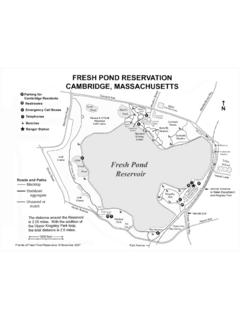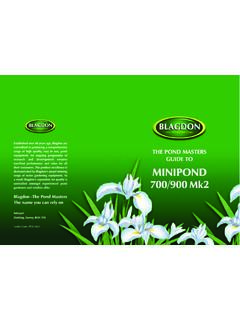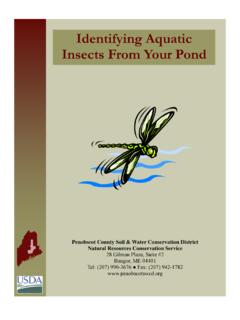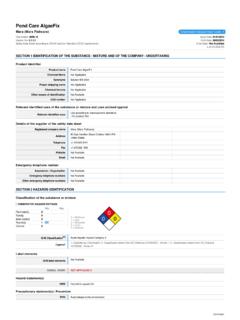Transcription of Cold Water Koi Keeping - koihealthadvisor
1 KHA Continuing Education Program The Winter Course cold Water Koi Keeping cold Water Effects on Koi and the Pond The Winter Course Richard E. Carlson The purpose of this section is to introduce the KHA to the effects of Water temperature on the ecology of the pond and physiology of the fish during the coldest months of the year. It is important to understand the dynamics of the pond as the seasons change and in particular, during cold Water conditions. For the purposes of this section, we will focus on the approaching Winter season. This course will teach the KHA how cold Water and changing Water temperatures affect the health of koi and also the ecology of the pond as they go into winter and emerge in the spring. As winter approaches in those climes that endure cold weather, we need to consider what is happening in our ponds as the Water turns cold and the fish become less active and the ecology of the pond changes.
2 When we consider the ecology of the pond, we look not only at the Water quality but also the effects of cold Water on the organisms within the ecology. Most notably, we need to focus on the metabolic changes that the fish will experience as the Water temperature drops and what effect the change in Water temperature has on the naturally occurring nitrifying bacteria and parasites in the pond. Water Temperature Effects One of the few things that we cannot effectively control in our pond s ecology is the Water temperature. The good news is that Mother Nature has provided our fish with a natural ability to adapt to the colder temperatures. This makes it our job to provide the best environment possible and to duplicate what Nature intended to happen in natural waters. The bad news is that Nature has equally provided the other organisms in our ponds the same survival mechanisms.
3 Throughout this course we are going to discuss not only the effects of Water temperature on our fish, but also on the nitrifying bacteria in our filters, the algae and plants in our ponds , the parasites that live on and around our fish, and finally on the disease-causing pathogenic bacteria that also inhabit our ponds . Managing a pond into and out of the cold weather season thus becomes a balancing act of Nature and the man-made effects to the ecology our ponds . The Physics of cold Water . The first thing to consider when looking at Water temperature effects is to ask how cold our pond Water really gets. As KHAs, we should know which temperature zone we live in and from this we can determine the expected frost line depth in our soil. Local agriculture extension services and most garden shops know this information, as do all building inspectors.
4 The importance of the frost line is that this is the depth that the soil temperature will potentially reach 32 degrees F. Below this depth, chances are that the soil temperature will remain at 35 degrees F or above. KHA Continuing Education Program The Winter Course Keep in mind that the soil around your pond will act as a natural insulator and keep the Water at the bottom of the pond at a temperature above 35 degrees F. If you had the ability to measure soil temperature at depths of twice the frost line, you should find that the soil temperature does not drop below 40 degrees or so, thus providing a nice natural insulator for our pond Water . Knowing the frost line depth should then be a major factor when determining the depth of your new pond or whether or not your fish can survive in an existing pond.
5 As a general rule, the pond depth should be at a minimum twice the depth of the frost line. For instance, in Zone 7, the expected frost line depth is 12 inches, so the minimum safe pond depth should be 24 inches below ground level. But these rules only apply to ponds built into the ground and not for ponds built above the ground. For above-ground ponds , the effects of cold air are remarkably more drastic and cause thicker ice coverings and lower temperatures throughout the pond as the natural insulating effects of the soil are not present. In evaluating the condition of a pond suitable for winter, pay close attention to the height above ground of the Water line as this will always cause problems with freezing. To understand how cold our ponds really can get, we need to use some principles of both physics and meteorology.
6 From physics, we first need to understand that mass has everything to do with how our ponds react to sub-freezing air temperatures. By mass, we are talking about volume in terms of length, width and almost most importantly depth. The greater the mass of the pond, the more assured we can be that natural cooling of our ponds will occur and Water temperatures will remain within predictable levels. Ice cubes in our freezer freeze because they lack the mass to avoid freezing solid. Also from physics, we know that as Water cools it becomes denser and this dense heavier Water sinks to the bottom. Fresh Water reaches its maximum density at 39 degrees F and this means that fresh Water as we know it, does not get colder than 39 deg F. Given a proper mass of our pond, we can expect the entire pond to get no colder than 39 deg F.
7 Although for ponds deeper than four or five feet below the frost line, we may expect some thermal layering (see below). So, as the cold (below 35 deg F or so) air and soil temperatures cause the pond Water temperatures to lower, the denser cooler surface Water sinks to the bottom and eventually the entire pond will achieve the same 39 deg F temperature. Since koi can withstand Water temperatures down to 35 deg F, this 39 deg F is a good temperature for our koi to appreciate its winter surroundings (see torpor, below). But with closed system ponds , such as most koi and goldfish ponds , we routinely see Water temperatures below this magical 39 deg F. This happens primarily because the ground around the pond and above the frost line is contributing to the cooling of the Water . We can make an analogy to the ice cubes in a freezer as the air surrounding the Water in the tray causes the Water in the tray to freeze solid.
8 The same thing is happening to closed system koi ponds and the smaller the pond, the worse the situation is likely to be. KHA Continuing Education Program The Winter Course But this begs the question: if Water can only reach 39 degrees F, how does it freeze? And here is where some principles of meteorology come into play. First, let us understand what "ice" really is: ice is the crystallization of Water particles in the air. We can prove this because we know that ice cubes and icebergs float. Freezing Water is a physics phenomenon as Water expands and becomes less dense as it freezes. Virtually everything else does the opposite. The composition of ice is 10% less dense than Water and so it floats. Freezing Water also expands which causes pipes to break. Why does this happen?? As mentioned, ice is formed by the crystallization of Water particles but this freezing occurs ABOVE the Water line.
9 During this process, air is trapped in the freezing crystals and this causes increased mass but less density as air has very little density. The meteorologists also tell us that evaporation is always occurring above a body of Water and with "calm" conditions, the air layer directly above or ponds becomes saturated with Water making the humidity 100% directly over the Water . Since we know that ice is formed by crystallizing Water particles, it is this layer of humid air directly over the pond surface that freezes, not the Water surface itself. The depth of the ice is determined by the air temperature at the ice surface interacting with the surface Water temperature. The colder the air, the lower the temperature of the ice will be just above the Water s surface. Between the surface of the Water and bottom of the ice is an air gap where a continuous 100% humidity level is maintained by the evaporation of the pond.
10 It is the interaction of the warmer pond Water and colder ice that causes an increase (or decrease) in ice depth. One other point about how Water freezes over the pond is that ice forms from the outside and moves the center. And this happens as the coldest part of the pond will be the edge and so this is were the ice block starts. The Effects of Salt on Water Temperature. As we are aware, salt is used in many ponds for a variety of reasons and many pond owners still use high levels of salt in the fall to help reduce parasite loads going into winter. In fact, not too many years ago it was an accepted practice to keep high levels of salt in the pond all winter long to guard against parasites. We know now that this is a bad practice as high levels of salt in the pond over winter can lead to serious, if not deadly, problems for the fish.







